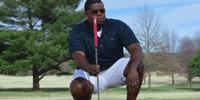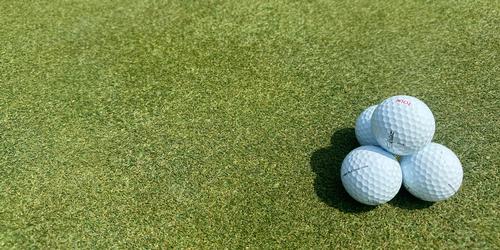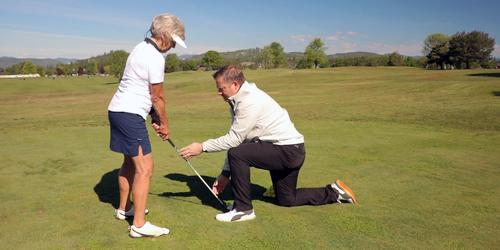The Putting Yipes, Yips!
Exploring The Putting Yips
By John Ehle
Henry Longhurst said; "Once you've had 'em, you've got 'em". Known variously as "the jumps', "the jitters", "the heeby jeebies" and my personal favorite; "whiskey fingers", the yips have been part of golf parlance forever. In the 20s, those who were afflicted were said to be from L. Frank Baum's the Land of Oz.
Ben Hogan had them so bad that some days he found it impossible to take the putter back. Some say that it marked the end of his career. Bernhard Langer was the poster boy for them right in the midst of a storied career. Sam Snead, Harry Vardon, Bobby Jones, Arnold Palmer and Tom Watson were all afflicted at one time or another.
Andy Podolak, PGA professional at Fire Ridge GC has never had them but believes that confidence in what you're doing on the greens is the key. "You've got to give a pep talk to that little guy on your shoulder. Nobody cares whether you shoot 60 or 100. You're in charge of your own game".
"If you have to go to the practice green and reconstruct your total putting routine....then you go there and rebuild it until you start making putts. Then you take what you've learned to the golf course and give it an audition".
Others may look for answers via equipment changes: long putters, fat grips, adjusted grips like the recently popular claw and the well-tested "left hand low". (for righties)
As a quantifiable part of the game, putting makes up at least 40% of the total strokes taken by golf professionals. The great putters like Tiger Woods and Steve Stricker consistently take fewer than 29 putts/round but they are in the minority. It's too much of the game to not do it well. For recreational golfers this number may climb higher than 40% but there is little doubt that practice time committed to putting is in all probability more likely to shave strokes than thumping buckets of balls with one's driver.
Opinions vary from one extreme to the other as to the origin of the yips. At one end of the spectrum are those who believe that it is an anxiety disorder; the psychology of choking. This may be the darkest of the theories as it implies some kind of weakness that is, at best, not "manly" and at worst a character flaw born of a lack of courage. At the opposite end are those who believe that the cause is purely a neurological deficit. The neurologists call this "occupational focal hand distonia". It's caused by the way you're wired and not because of anxiety. Try to balance a golf ball on a golf ball and you should find a practical demonstration of distonia.
The golf course is probably the wrong place to do science. No scientist, I, but the term "clinical trials" is how science should probably be done. A controlled environment is the key. Whether you're looking at evidence of "choking" or a measure of occupational focal hand distonia, being able to quantify results is the key. Without it the opportunity to intervene is unlikely.
Golf gurus and teachers are likely to come down on the side of psychological origins. Conventional knowledge would suggest that instruction can overcome the uncertainties embedded in something as potentially complex as the mind/putter duality. If the teacher can intervene and promote learning and improved performance, improved confidence may result. If, however, the obstacle is something as potentially complicated as one's hardwire, interventions might be significantly more elusive.
Several years ago there was a brief but enthusiastic perception that some golfers were steadying frayed nerves with beta blockers. The effect, supposedly, was a slowing of the pulse resulting in a more focused approach to putting. Better living through chemistry?
Really radical interventions that have been bandied about included botox injections in the hands to quiet the effects of distonia. Probably a treatment which would find very few subscribers.
Until researchers can segregate behaviors that are associated with the extremes on this spectrum, it seems that a putting lesson from your PGA professional and a regular, large dose of practice may be the best prescription. Enjoy golf.
Article Tags: The Putting Yips
Revised: 08/01/2010 - Article Viewed 31,727 Times
About: John Ehle
![]() John Ehle writes for GolfWisconsin.com, GolfTrips,com and other golf-related sites in the US. He has attended 6 Open Championships in the British Isles and many men's and women's US Opens and PGA Championships as well as Ryder Cups and President's Cups.
John Ehle writes for GolfWisconsin.com, GolfTrips,com and other golf-related sites in the US. He has attended 6 Open Championships in the British Isles and many men's and women's US Opens and PGA Championships as well as Ryder Cups and President's Cups.
His primary international writing is golf course reviews and travel articles. He also writes about golf equipment and other golf-related products. Most recently he traveled to Cuba and will be in SE Asia for 6 weeks in February and March, 2012.
He writes a weekly column for a metropolitan newspaper in the Milwaukee, Wisconsin area. He is a 10 handicap golfer and has competed in many Wisconsin State Golf Association events.














